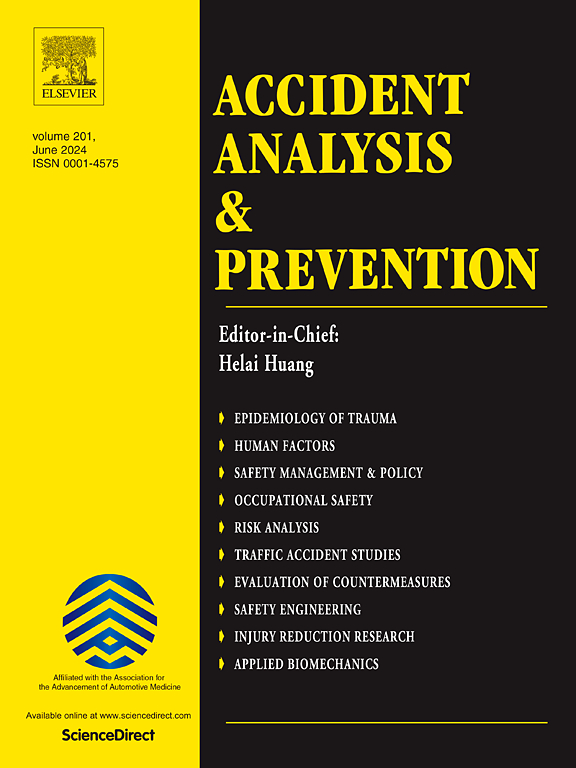配备ehmi的自动驾驶车辆对行人过马路行为和安全的影响:基于盲点场景的研究
IF 5.7
1区 工程技术
Q1 ERGONOMICS
引用次数: 0
摘要
盲点碰撞是对行人安全的严重威胁,但往往被忽视,经常造成严重伤害。本研究探讨了配备外部人机界面(eHMIs)的自动驾驶汽车对行人过马路行为和安全的影响,重点研究了自动驾驶汽车在行人和邻近交通之间造成相互盲点的场景。在一项有51名参与者的虚拟现实实验中,他们模拟了在行人视线受阻的情况下,在让路的卡车前过马路的情况,并采用了三种ehmi:“走”、“不要走”和“小心!”盲点”。在卡车盲区内的车辆对行人表现出主动和被动制动行为。结果表明,基于颜色、文字和符号的eHMI设计提高了行人的理解能力。然而,忽视盲点风险的“步行”eHMI可能会导致危险的过马路行为。相比之下,“不要走路”eHMI有效地减少了不安全的过马路行为,尽管让路的卡车有时会引起行人的困惑。“小心!盲点的eHMI提高了警觉性,但并不比直接的“不要走路”指示更有效。本研究为将动态环境感知和危险预警整合到eHMI设计中,提高道路使用者的盲点意识提供了实证依据。研究结果强调了综合战略的重要性,包括政策制定、教育和基于虚拟现实的培训,以确保在盲区环境中有效部署和公众理解eHMIs。本文章由计算机程序翻译,如有差异,请以英文原文为准。
Effect of eHMI-equipped automated vehicles on pedestrian crossing behavior and safety: A focus on blind spot scenarios
Blind spot collisions are a critical and often overlooked threat to pedestrian safety, frequently resulting in severe injuries. This study investigates the impact of automated vehicles equipped with external human–machine interfaces (eHMIs) on pedestrian crossing behavior and safety, focusing on scenarios where AVs create mutual blind spots between pedestrians and adjacent traffic. A virtual reality experiment with 51 participants simulated crossing situations in front of yielding trucks with obstructed pedestrian visibility, featuring three eHMIs: ‘Walk,’ ‘Don’t Walk,’ and ‘Caution! Blind Spots’. Vehicles within the truck’s blind spot exhibited proactive and reactive braking behaviors toward pedestrians. The results indicate that eHMI designs based on color, text, and symbols enhance pedestrian understanding. However, the ‘Walk’ eHMI, which ignores blind spot risks, may lead to dangerous crossing behaviors. In contrast, the ‘Don’t Walk’ eHMI effectively reduced unsafe crossing behaviors, though yielding trucks sometimes caused pedestrian confusion. The ‘Caution! Blind Spots’ eHMI increased alertness but was not significantly more effective than the direct ‘Don’t Walk’ instruction. This study provides empirical evidence for integrating dynamic environmental perception and hazard warnings into eHMI designs to raise road users’ awareness of blind spots. The findings emphasize the importance of comprehensive strategies, including policy-making, education, and VR-based training, to ensure the effective deployment and public understanding of eHMIs in blind spot environments.
求助全文
通过发布文献求助,成功后即可免费获取论文全文。
去求助
来源期刊

Accident; analysis and prevention
Multiple-
CiteScore
11.90
自引率
16.90%
发文量
264
审稿时长
48 days
期刊介绍:
Accident Analysis & Prevention provides wide coverage of the general areas relating to accidental injury and damage, including the pre-injury and immediate post-injury phases. Published papers deal with medical, legal, economic, educational, behavioral, theoretical or empirical aspects of transportation accidents, as well as with accidents at other sites. Selected topics within the scope of the Journal may include: studies of human, environmental and vehicular factors influencing the occurrence, type and severity of accidents and injury; the design, implementation and evaluation of countermeasures; biomechanics of impact and human tolerance limits to injury; modelling and statistical analysis of accident data; policy, planning and decision-making in safety.
 求助内容:
求助内容: 应助结果提醒方式:
应助结果提醒方式:


